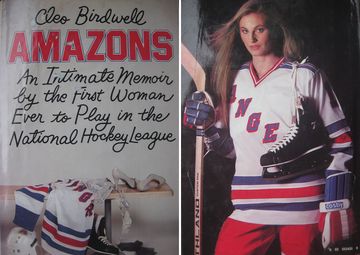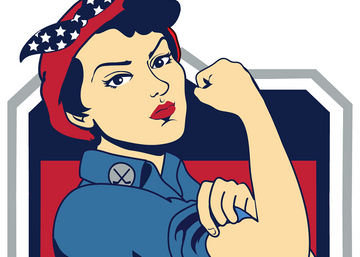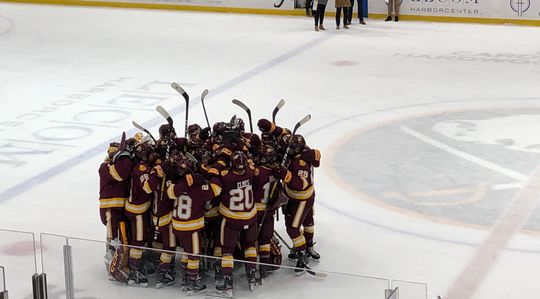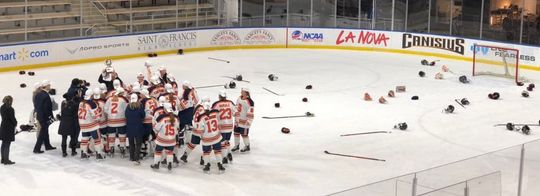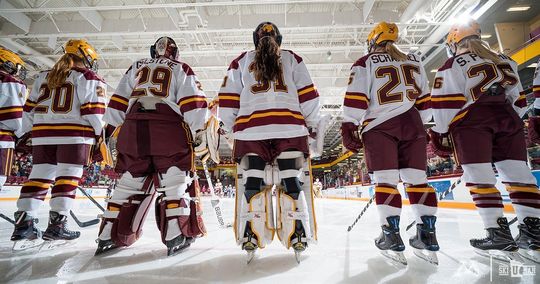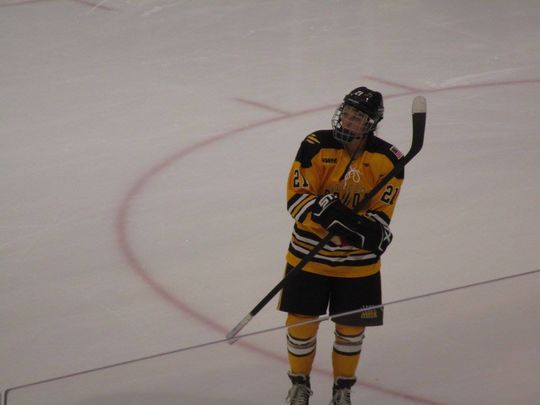IMAGE: Wisconsin's Sarah Nurse shoots on Minnesota's Amanda Leveille during the 2015 Frozen Four/Photo by author.
Disclaimer: This is one writer’s attempt to sum up and introduce collegiate women’s hockey. Information is subject to bias and opinion and can (and should) change. Please don’t consider this the be-all, end-all, but simply a starting point on learning the game.
As the puck is set to drop on the inaugural season of the NWHL and the ninth season of the CWHL, more and more attention is being paid to women’s hockey in the US.
But before there was professional women’s hockey, there was NCAA collegiate hockey. More than three-quarters of the women lacing up for the two professional leagues this season got their start in NCAA collegiate hockey.
Whether you’re a new women’s hockey fan, or you love the pros but have never delved into the college waters, here’s a primer that should help you better understand.
HISTORY
There are currently 36 women’s collegiate hockey teams.
Women’s ice hockey was an officially sanctioned NCAA sport in the 2000-2001 season, but the roots of collegiate hockey go back 35 years from there. Women’s collegiate hockey started long before it was NCAA-sanctioned. Brown University had the first team in 1965. The first Ivy League tournament happened in 1976. The ECAC had their first tournament in 1984.
Women’s ice hockey became an Olympic sport in 1998. There was no formal league or plan in place in the US to train and develop players. During the 1997-1998 season, the American Women's College Hockey Alliance was born, and it was financed by the US Olympic Committee. That original league held their own National Championships in 1999 and 2000, which were won by Harvard and Minnesota. Those championships are generally not counted when talking about national titles won by a university -- only NCAA Championships.
Early on, the NCAA was dominated by the University of Minnesota-Duluth (UMD), who won the first three national championships and have five total. Harvard, Brown and St. Lawrence were among the early powerhouses -- these schools had hosted “club” level hockey for many years before turning it into a sanctioned intercollegiate sport. Wisconsin won five of seven national championships from 2006 to 2011 and was runner up in 2008 and 2012. Minnesota has been the team to beat in recent years, winning three of the last four titles.
2001 National Champion: UMD
Runner Up: St. Lawrence
2002 National Champion: UMD
Runner Up: Brown
2003 National Champion: UMD
Runner Up: Harvard
2004 National Champion: Minnesota
Runner Up: Harvard
2005 National Champion: Minnesota
Runner Up: Harvard
2006 National Champion: Wisconsin
Runner Up: Minnesota
2007 National Champion: Wisconsin
Runner Up: UMD
2008 National Champion: UMD
Runner Up: Wisconsin
2009 National Champion: Wisconsin
Runner Up: Mercyhurst
2010 National Champion: UMD
Runner Up: Cornell
2011 National Champion: Wisconsin
Runner Up: Boston University
2012 National Champion: Minnesota
Runner Up: Wisconsin
2013 National Champion: Minnesota
Runner Up: Boston University
2014 National Champion: Clarkson
Runner Up: Minnesota
2015 National Champion: Minnesota
Runner Up: Harvard
Minnesota also owns a title that may never be surpassed. They went undefeated over the 2012-2013 season and had a 62-game unbeaten streak from February 17, 2012 to November 17, 2013. It’s the longest streak in collegiate hockey, either men’s or women’s. They won back-to-back national titles over the stretch.
It’s an incredible feat.
The Patty Kazmaier Award is given to the top female collegiate player every year. The award is named in honor of the late Patty Kazmaier-Sandt, a four-year varsity letter winner for Princeton from 1981 through 1986, who also played field hockey and lacrosse. Patty died on February 15, 1990 at the age of 28 from a rare blood disease.
Harvard leads all schools with six Patty winners, followed with Wisconsin with four.
1998 Brandy Fisher - New Hampshire
1999 A.J. Mleczko - Harvard
2000 Ali Brewer - Brown
2001 Jennifer Botterill - Harvard
2002 Brooke Whitney - Northeastern
2003 Jennifer Botterill - Harvard
2004 Angela Ruggiero - Harvard
2005 Krissy Wendell - Minnesota
2006 Sara Bauer - Wisconsin
2007 Julie Chu - Harvard
2008 Sarah Vaillancourt - Harvard
2009 Jessie Vetter - Wisconsin
2010 Vicki Bendus - Mercyhurst
2011 Meghan Duggan - Wisconsin
2012 Brianna Decker - Wisconsin
2013 Amanda Kessel - Minnesota
2014 Jamie Lee Rattray - Clarkson
2015 Alex Carpenter - Boston College
As shown by the number of Olympians on the above list, the strength of competition in NCAA hockey has developed some of the top talent in the world. While the top US-born talent has long been culled from the NCAA, international players are now turning to the league as the best place to train, learn, and develop. At the 2002 Salt Lake City Olympics, just eight members of Team Canada had played in the NCAA. In contrast, every member of the US team in Sochi and 14 of the 21 Canadian skaters were current or former NCAA players.
An early strategy used by UMD’s coach Shannon Miller was to recruit top talent from outside the United States. The draw of a degree, combined with stellar training facilities and top-tier coaching, was an enticing one. At the 2006 Turin Olympics, there were 22 players with NCAA experience on rosters other than the US or Canada. Fifteen of those players had played at UMD. The other seven represented just five other schools
It was an effective recruiting strategy for a smaller school that may not have the appeal or draw of large universities like Minnesota or Harvard. It was so successful that other small programs began looking outside North America for top talent. At Sochi in 2014, there were 26 players on rosters other than US and Canada that had NCAA experience, and they represented nine different schools.
Every member of Team Canada and Team USA at the 2015 IIHF Women’s World Championships has played NCAA college hockey.
Former Wisconsin Badgers on Team USA at Sochi included captain Meghan Duggan, Hilary Knight, Brianna Decker, and goalie Jessie Vetter. Minnesota was represented by Gigi Marvin, Amanda Kessel, Megan Bozek, and Lee Stecklein. Current Boston College Eagle and Patty Kazmaier winner Alex Carpenter was joined by former Eagle Molly Schaus. The Lamoureux twins spent a year at Minnesota before transferring to North Dakota. Julie Chu, Josephine Pucci and Lyndsey Fry represented Harvard. You can still see Kendall Coyne speed down the ice for Northeastern University this season.
The bane of US women’s hockey’s existence, Canada's Marie-Philip Poulin, has just finished a career at Boston University.
ORGANIZATION
If you’re familiar with the format of college hockey, go ahead and skip to the next bold heading.
One of the first things to know is that there are several small schools that play Division I hockey, despite the fact that their other athletic teams compete in Division II or III. That’s a rule that’s since changed with the NCAA - now if you have one team playing DI, they all have to play in the same division. But in both and men’s collegiate hockey, you'll see St. Cloud State and Union competing against Wisconsin, Harvard, and Minnesota.
There are four conferences in women’s hockey --and they do not align with other, traditional collegiate sports conferences.
College Hockey America (CHA) formed in 2002. Its current members include Lindenwood, Mercyhurst, Penn State, RIT, Robert Morris and Syracuse.
The Eastern Collegiate Athletic Conference (ECAC) began sponsoring an invitational women's tournament in 1985. ECAC teams began playing an informal regular season schedule in the 1988–89 season, with the conference officially sponsoring women's hockey beginning in the 1993–94 season. Twenty-four different teams have called the ECAC home in their history. The only NCAA Championship not won by the WCHA belongs to Clarkson, the 2013-2014 winners. ECAC alumnae have won 37 Olympic Gold Medals and 10 Patty Kazmaier Awards.
The current members are Brown, Clarkson, Colgate, Cornell, Dartmouth, Harvard, Princeton, Quinnipiac, Rensselaer, St. Lawrence, Union, and Yale.
Hockey East (HE) expanded to women’s teams for the 2002-2003 season. In their 13-year history, they sent nine teams to the Frozen Four and 19 teams to the NCAA Tournament.
The current members are Boston College, Boston University, Connecticut, Maine, Merrimack, New Hampshire, Northeastern, Providence and Vermont.
The Western Collegiate Hockey Association (WCHA) began sponsoring women’s hockey in the 1999-2000 season. Fifteen of 16 NCAA championships have been won by members Minnesota, Wisconsin and University of Minnesota-Duluth. Six league members have won Patty Kazmaier Awards.
The current members are Bemidji State University, Minnesota State-Mankato, University of Minnesota, University of Minnesota-Duluth, North Dakota, Ohio State, St. Cloud State and Wisconsin.
There is one independent team: Sacred Heart.
RULES - AKA There is no checking in women’s hockey
The biggest difference between men’s and women’s hockey is that women’s hockey has no body-checking -- but don’t let that confuse you into thinking that this is going to be a non-contact game.
You can download the full NCAA hockey rules book here.
There is just a single rule in the book that pertains only to the women’s game. Rule 94.
Rule 94 - Rules for Women’s Ice Hockey
94.1 Rules for Women’s Ice Hockey - The following rules are to be used for women’s ice hockey competition:
94.2 Body Checking - Body checking is not permitted in any area of the ice. Body checking occurs when a player’s intent is to gain possession of the puck by separating the puck carrier from the puck with a distinct and definable moment of impact.
PENALTY—A minor, major or disqualification, at the discretion of the referee.
94.3 Angling - Angling is permissible. Angling is a legal skill used to influence the puck carrier to a place where the player must stop due to a player’s body position.
94.4 Incidental Contact - Incidental contact, when two players collide unintentionally, may occur.
Whether or not checking should be a part of the women’s game is a hotly contested issue.
As best I can gather, there are two major reasons why checking isn’t allowed:
The first is to encourage the continued enrollment of young players and growth of the game.
The second is that women’s hockey is not a million-dollar enterprise. The women who play in college will almost all be going on to other careers. The women who play internationally often hold additional jobs to support themselves. The risk of injury that checking adds is tough to justify and overcome for women who are not likely ever to sign large contracts, and who are playing essentially for the love of the game (and maybe a shot at a medal every couple of years).
On the other hand, there are plenty of women who advocate for the addition of checking. Former Minnesota and current Team Finland goalie Noora Räty thinks injuries might actually go down if girls were trained on not just how to check, but how to absorb one.
The fact is that young girls are not taught how to take a hit. They learn the game differently and as a result, they don't play the game with their heads up, looking for oncoming players. Räty disagrees with this practice. She blames this lack of preparedness for a lot of head injuries and concussions in the women’s game. Having played in both a men’s professional league in Finland and internationally at the top level for women, she brings a unique perspective.
Boys are taught to keep their head on a swivel. If they’re in the corner or against the boards, they’re constantly aware and looking to see who might be coming to knock them off the puck. Girls don’t learn to play that way and Räty said she said they’re unprepared when someone puts their body on them. Their bodies aren’t prepared to take a hit.
The perceived lack of a future in women’s hockey is one of the reasons that so many people were excited by the advent of the NWHL. College hockey has been the end of the road for many talented women. A small handful get to keep playing internationally. A lot of fans are attracted to the fact that these are top-tier athletes playing for not much more than the love of the game. They practice, go to the weight room, travel extensively, and basically work their butts off to play while also attending world-class academic universities. It’s a sacrifice.
Detractors of women’s hockey blame the lack of hitting for their lack of interest, but when I hear a hockey fan say they don’t like women’s hockey because it’s boring and they don’t hit each other, I just assume they’ve never actually watched a game or they aren’t really fans of the game of hockey.
To me, to love the game of hockey is to love fast skating, crisp play, and pretty passes, and the lack of hitting in the women’s game actually brings you more of those things than in the men’s game.
Women’s hockey is, first and foremost, a game of finesse. Since they can’t just knock each other over to win the puck from each other, they actually have to employ skill and dexterity to get through a zone and beat a defender. You’ll see a lot more fancy puck-handling, toe drags, and dangles. It seems that a fan of the game of hockey would appreciate these differences and the skill that's needed to accomplish them.
Lest you think these are delicate, shrinking violets, know that there are few girls-only hockey teams and there were even fewer 10-15 years ago. Pretty much every woman you’ll see on the ice grew up playing hockey with boys. Ultimately, this is very much a growing sport (think girls' soccer before the boom that was brought about by the 1999 World Cup). These are women who grew up playing the sport on boys' teams because that was the only option available to them. These aren’t just really good hockey players for women -- they’re really good hockey players, period.
Though checking is a penalty on the women’s side, you’ll still see plenty of contact. In fact, you’ll see girls run each other over, hit the ice, and hit the boards, and generally think to yourself "that’s not a check?" The simple answer is that yeah, it probably was. That’s one of the arguments in favor of making checking legal. Every ref calls the rule differently and it is subjectively interpreted.
A Wisconsin/Minnesota game will be very physical. A game against North Dakota may be even more physical. It’s the nature of the skill level. It’s also one of the differences between so called east and west coast teams. (The “west” being the WCHA and the “east” being everyone else.) The WCHA style of play tends to showcase more contact and physicality. The east coast style is often more about speed. That’s why it’s so fun to watch teams from the two factions play -- how will each side match up?
Regardless of the interpretation of checking, it is legal for the players to use their bodies to their advantage. Women’s hockey will feature a lot more different body sizes than you’ll see in a men’s game. The lack of hitting does allow smaller women a chance to use their other skills on the ice and have an impact while not getting constantly hip-checked. It leads to drastically different and interesting styles of play.
If you watched the US Women’s Olympic team in Sochi, you saw two different forwards who embody these differences. Northeastern’s Kendall Coyne is 5’2" and uses her incredible speed to elude defenders and slash toward the net. At the same time, former Badger Hilary Knight is 5’11" and uses her height (and the fact that she’s solid muscle) to establish herself in front of the net, fight off defenders and get position in front of the goal. Both styles are incredibly effective.
There tend to be fewer penalties and a lot fewer stoppages in play in women's hockey. Since they’re rarely televised, there are also no TV timeouts. Folks who aren't used to this will want to be able to get up and move around during a game, but they'll miss a lot of action that way.
POSTSEASON
There are eight teams that play in the women’s hockey NCAA Tournament. Each of the four conferences receive an auto-bid into the NCAA Tournament. The team that wins each conference’s postseason tournament receives that bid. The other four spots are assigned based on Pairwise rankings* -- usually the next four teams in the poll.
*Pairwise is complicated and though we don’t know the exact math involved, it uses record against common opponents, record against teams under consideration, head to head competition, and the Ratings Percentage Index (RPI). Read more on it here.
MISCELLANEOUS
Two other things are helpful to know when it comes to diving into women’s hockey fandom.
There is a mostly tongue-in-cheek rivalry between the East and the so-called West, as mentioned above.
For fans from the East, the bias they see towards the WCHA is tired and maybe not-so-deserved. Despite the national championships, there are, overall, more teams from the East that make the NCAA tournament. So while the top team may be from the WCHA, the East has more quality top to bottom. There’s an argument that the top teams of the WCHA do not schedule non-conference series against the best teams of the East, as well.
For fans of the WCHA, the argument is that the league owns 15 of the 16 national championships. WCHA teams continue to oust East teams en route to the Frozen Four. Teams from the eEast, with the exception of Clarkson, have been unable to unseat WCHA teams in the playoffs. East teams have not proven they can beat WCHA teams time and again. WCHA teams basically beat up each other and have to play nationally ranked teams multiple times over the course of the season, which hurts their overall record.
The perpetually unanswered question of women’s collegiate hockey is how teams like North Dakota and Bemidji State -- who are currently nationally ranked, but are in the middle of the WCHA -- would fare if they played in the ECAC or Hockey East. Vice versa, how would Harvard or Boston College fare in the WCHA? It’s something we’ll never know, but it’s the basis for a lot of the East vs West infighting.
The last thing to talk about in women’s college hockey is parity -- or possibly the lack thereof. Just 10 teams have ever played in a national championship game. There can be a wide gap between the top and bottom teams in a conference. I have no interest in defining which teams are considered to be top tier or not -- that’s also a great debate.
But what I can tell you is that the parity gap continues to close.
Bemidji State was 11-21-4 in the 2013-2014 season. Last season they were 21-17-1, and beat Minnesota, Wisconsin, and North Dakota. They also have their first US National Team player in Stephanie Anderson.
Lindenwood was in just their fourth season as an NCAA program last season. Though they won just 10 games, they had two wins against RIT, a team that played in the NCAA tournament, and a win over Bemidji State.
Minnesota State-Mankato had just three wins all last season, but have already started this year 2-1-1.
Vermont finished last season 15-19-2, but had wins over North Dakota, RIT, and Boston University.
Each win over ranked and tournament teams are building blocks for programs and show how the game continues to grow.
For the most part, what you’ll note in games between teams from the subjective different tiers is a difference in foot speed, endurance, and puck-handling skills. You’ll see teams get tired and unable to sustain their pace against teams like Minnesota, Wisconsin, Harvard, and Boston College. The game may be close for the first period and even into the second period, but then fatigue sets in.
A great place to find more information about women's college hockey is USCHO.com. Not only will you find good articles and the weekly polls, but their fan forum's a great source of information and a good place to get questions answered. The standard warnings about internet forums apply, but I've had positive experiences there. The women's hockey fandom is small, so you have to find like-minded folks where you can.
Finally, here's my Twitter list of all the official accounts of collegiate women's hockey programs.
And here's a list I made of people that regularly talk about women's hockey. That includes the pros, but you'll find a lot of college hockey chatter in there.
Come back each day this week for a breakdown of each conference - the teams, their history, players to watch, social media and how to watch them online.
Check out all of Nicole's 2015-16 NCAA previews:


